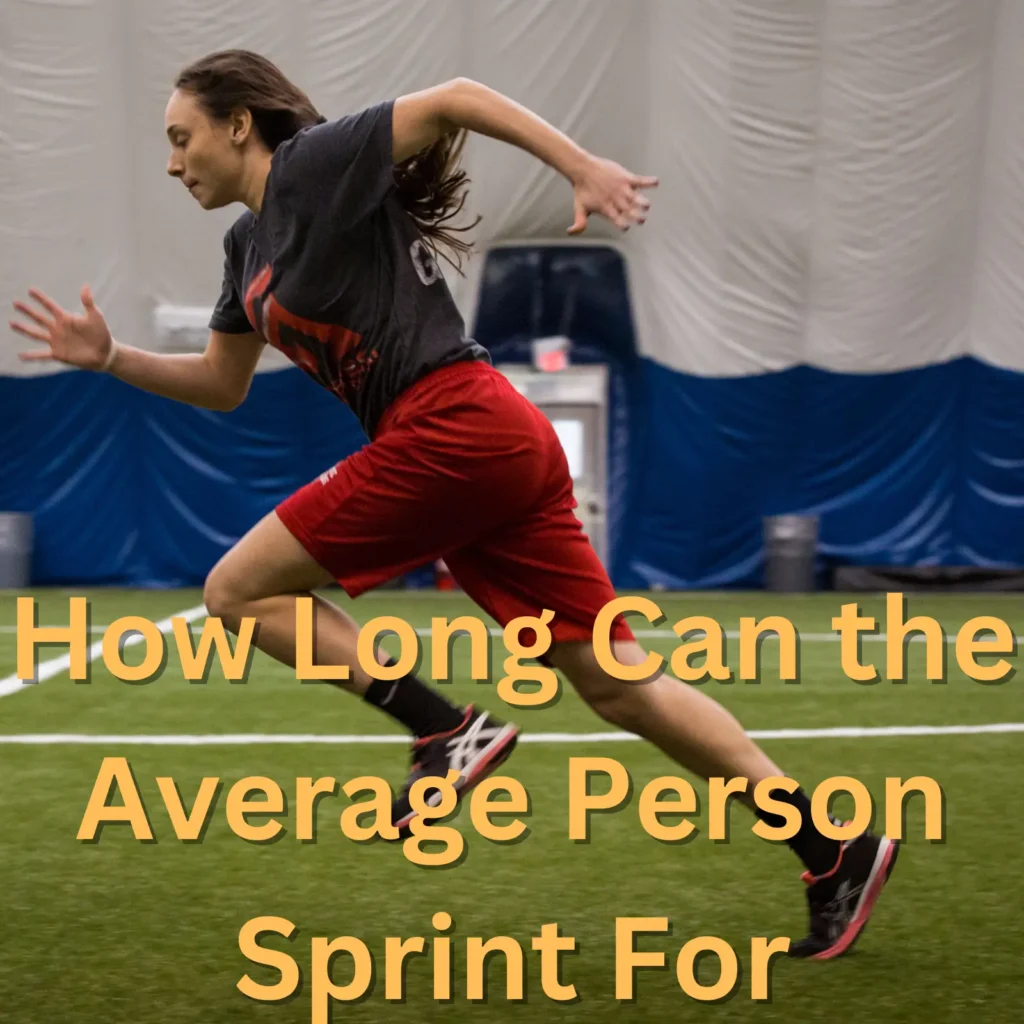
Introduction
While elephants rely on their immense size and strength, giraffes rely on their ability to reach very tall trees that no one else can forage or ants use their numbers to prevail in a wide variety of environments humans did something similar to thrive back in the day.
Before guns and the internet some populations relied on their ability to “persistence hunt” to acquire food and resources, this tells us a lot about or potential but not enough, so let’s dive deep into it.
If you ever wondered how long can the average person sprint for? Or maybe you just want to know how fast professional athletes can run when they go all out on the field. Whatever doubts you have will be gone after reading this article, we’ll cover as much as we can about sprinting, marathoning and well running in general.
How Long Can the Average Person Sprint For

According to some studies sprinting is most effective in the 5 to 15 second range, this means that most runners can expect to cover between 30 to 100 yards quickly. But after that fatigue kicks in and speed goes down quickly.
If you ever tried running as fast as you could without training this could be even less, with untrained people probably not being able to run much more than 10 seconds at most.
But that doesn’t tell us all we need to know about sprinting or even running for that matter, so let’s explain some concepts and go much deeper into what makes some people faster than others!
Acceleration
Acceleration is a pretty obvious concept really; how fast can you reach your top speed? That’s acceleration in a nutshell. Running fast is important but sometimes running fast quickly is even more important, this is most important in specific sports but it’s useful for every athlete out there.
Here are some examples of where acceleration could be useful (outside of track and field and similar):
Soccer or Futsal
Acceleration is extremely important in this sport, it’s obvious to anyone that has watched even a single minute of this sport running is the main thing players do the entire game with or without the ball.
Quick forwards that can reach top speed quickly can completely change the course of a match in a single second, beating their man easily with just speed alone, defenders too need speed just to be able to stop them.
Basketball
While basketball doesn’t even come close to soccer in terms of how important quickness can be, it’s still a decent example. Players like Allen Iverson leveraged their great speed and agility to constantly battle against players much taller than him for more than a decade.
Tennis
Tennis is another sport which might not look like it benefits as much like soccer, but nothing could be farther from the truth. Fast players can consistently break more serves than slower players.
While tennis is definitely becoming more static every year, the most decorated players today (Nadal, Djokovic and Federer) are still lean and quick, speed is an integral part of their game.
American Football
While running plays have been declining for years, running is still about a third of all offenses. This means that American football is another sport where speed and acceleration are king.
Running backs in American football excel at the ages of 25-28, which correlates perfectly with peak running ability.
Top Speed

Once a runner reaches their peak speed, acceleration no longer plays a part and only top speed matters. Top Speed is defined as their maximum speed.
There are multiple things that together make up a runner’s speed, some of these are: stride length, stride frequency, explosive strength.
Stride length and stride frequency are generally impacted the most by height, weight and genetics, but training also has a say in dictating a runner’s top speed. Think about this as how fast can the runner touch the ground and push himself forward.
Explosive strength is another big factor, stronger runners can “push” themselves off the ground harder and in turn increase their speed even if they have to carry more weight.
Generally smaller leaner runners do better at endurance events while bigger and stronger runners do well at sprints.
Endurance

Endurance is basically how long a runner can keep running for, but when we’re talking about sprinting and running, endurance is how long you maintain peak performance.
Training and genetics both play a part on a runner’s endurance. Some human populations are extremely successful in the Olympics for example, with some villages in Africa even having multiple Olympics winners among their ranks.
But the differences in more general sports are much less noticeable, with small 1 second differences not really being enough to differentiate athletes.
Agility
Agility might seem like it doesn’t really have much to do with sprinting; In general I’d agree but when we talk about general performance and running in sports, agility can be the difference between a truly quick player and a clunky “quick” player.
Remember agility is simple how fast you can change direction, in track and field this doesn’t really factor in. But in sports like Soccer, Basketball, Tennis and so on it does.
Agile players can beat faster players by quickly changing directions basically invalidating everything else, so it’s something you ought to keep in mind.
Muscle Fiber Types
You might have heard about muscle fiber types somewhere, well they’re real and they’re super important for running.
There are two types of muscle fibers: slow-twitch and fast-twitch. Slow-twitch muscle fibers are better suited for endurance activities like distance running, while fast-twitch muscle fibers are better suited for explosive activities like sprinting but they do intersect to some degree.
Fast-twitch muscle fibers are specialized for quick movements, this makes them perfect for explosive movements like sprinting. Everyone has a mix of both types of fibers but only those runners with more fast twitch muscle fibers can really excel at short distance running.
How can a sprinter determine their muscle fiber type?
There are a bunch of ways of determining muscle type but they’re all not perfect and some are not viable for most athletes.
A muscle biopsy can definitely tell you which types you have more of, however this is an invasive and expensive procedure so most people opt not to do this.
Genetic testing is another way to determine muscle fiber type, this one is similar to the first one but instead of taking a direct muscle sample from the athlete it focuses more on taking DNA samples and comparing them.
Besides those tests there are also general performance measures that can somewhat determine what type of runner you are, they are not as definite as the other ones mentioned but they’re not invasive and not expensive so they’re good more most runners.
One thing, remember that muscle fiber type is just one factor out of many, without proper training, nutrition and technique you will not reach your potential!
How To Run Faster
A common question, and for good reason. We’ve already covered why sprinting is useful so it’s only natural that we talk a bit about this.
In general, getting faster is a mix of two things strength training which helps athletes develop explosive strength and sprint-specific drills like resistance band running and uphill running to develop proper technique and endurance.
There is a limit to how fast you can be, as we mentioned before the ratio of fast to slow twitch fibers will determine your potential for either endurance running or sprinting. Trying different distances will let you know what you excel at, but some people are balanced runners and do equally good and bad at both.
Conclusion
As you can see sprinting (and running in general) is a fascinating and complex subject. Requiring both great strength, proper technique and enough endurance.
Almost every sport in the world benefits from speed, even if it is not enough to give you an edge. In general people who can run very fast or for very long are excellent athletes that excel at many different sports.
And while there are genetic limits that we can’t really push through, with enough training anyone can improve their speed to a reasonable degree, only professionals might really struggle to increase their times.
Whether you’re an athlete or just a casual runner, knowing all of this puts you ahead of the curve in your fitness journey too, there are a lot of myths and misconceptions going around, so make sure to do enough research before doing anything weird!